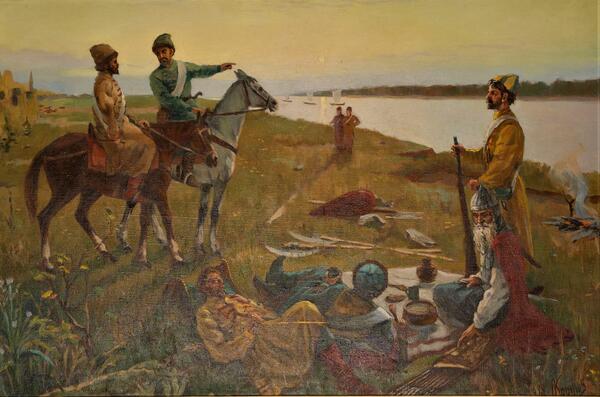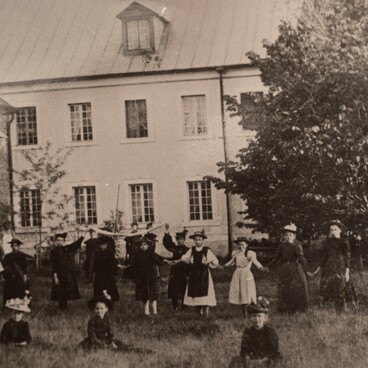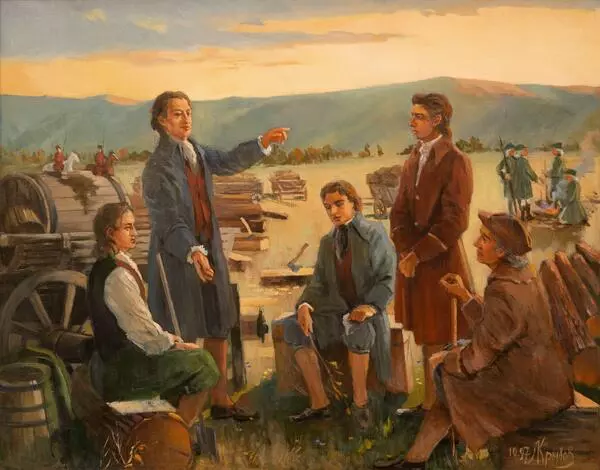The Russian authorities took measures to ensure the safety of Sarepta, whenever possible, since the German colony wealth was more than once exposed to the threat of ruin and plunder. The painting by Lev Krylov depicts a small Cossack outpost located on the steep bank of the Volga with a good view and an advantageous strategic position. Due to frequent attacks on the town the Sareptians organized constant night guards and a horse patrolling at the mouth of the Sarpa River ready to immediately inform Sarepta when a suspicious vessel approached.
The Volga Cossacks host carried out a guard, patrol, detective, postal service. They also had a convoy duty: the Cossacks, together with the military, accompanied the Sareptians on their journey to the place of the future colony. The Cossacks served mainly on the territory along the banks of the Volga from Saratov to Astrakhan. The host consisted of 1057 Cossacks and seniors.
The first military ataman of the Volga army was Makar the Persian. The army owned a vast territory along the right bank of the Volga and the left bank of the Ilovlya, bordering in the north with the lands of DmItrievsk (Kamyshin), in the south - Tsaritsyn (Volgograd), in the west - with the lands of the Don Cossacks. The host received from the treasury a monetary and grain salary, allowances for the construction of houses and for ammunition.
The Cossacks were on military service from the age of 15. They retired due to old age or illness. They served every year in different venues - in Saratov, Astrakhan and other settlements along the Volga. Cossacks were appointed to capture robbers in various provinces.
To protect Sarepta from the raids of the Kuban Tatars and Kalmyks a fortress was erected at the expense of the fraternal community. The construction was completed on early 1770. The fortress garrison consisted of officers and soldiers of the Tsaritsyn garrison and the Cossacks of the TsarItsyn Cossacks. The Sarepta fortress garrison quantity ranged from 20 to 100 people.
The Volga Cossacks host carried out a guard, patrol, detective, postal service. They also had a convoy duty: the Cossacks, together with the military, accompanied the Sareptians on their journey to the place of the future colony. The Cossacks served mainly on the territory along the banks of the Volga from Saratov to Astrakhan. The host consisted of 1057 Cossacks and seniors.
The first military ataman of the Volga army was Makar the Persian. The army owned a vast territory along the right bank of the Volga and the left bank of the Ilovlya, bordering in the north with the lands of DmItrievsk (Kamyshin), in the south - Tsaritsyn (Volgograd), in the west - with the lands of the Don Cossacks. The host received from the treasury a monetary and grain salary, allowances for the construction of houses and for ammunition.
The Cossacks were on military service from the age of 15. They retired due to old age or illness. They served every year in different venues - in Saratov, Astrakhan and other settlements along the Volga. Cossacks were appointed to capture robbers in various provinces.
To protect Sarepta from the raids of the Kuban Tatars and Kalmyks a fortress was erected at the expense of the fraternal community. The construction was completed on early 1770. The fortress garrison consisted of officers and soldiers of the Tsaritsyn garrison and the Cossacks of the TsarItsyn Cossacks. The Sarepta fortress garrison quantity ranged from 20 to 100 people.







